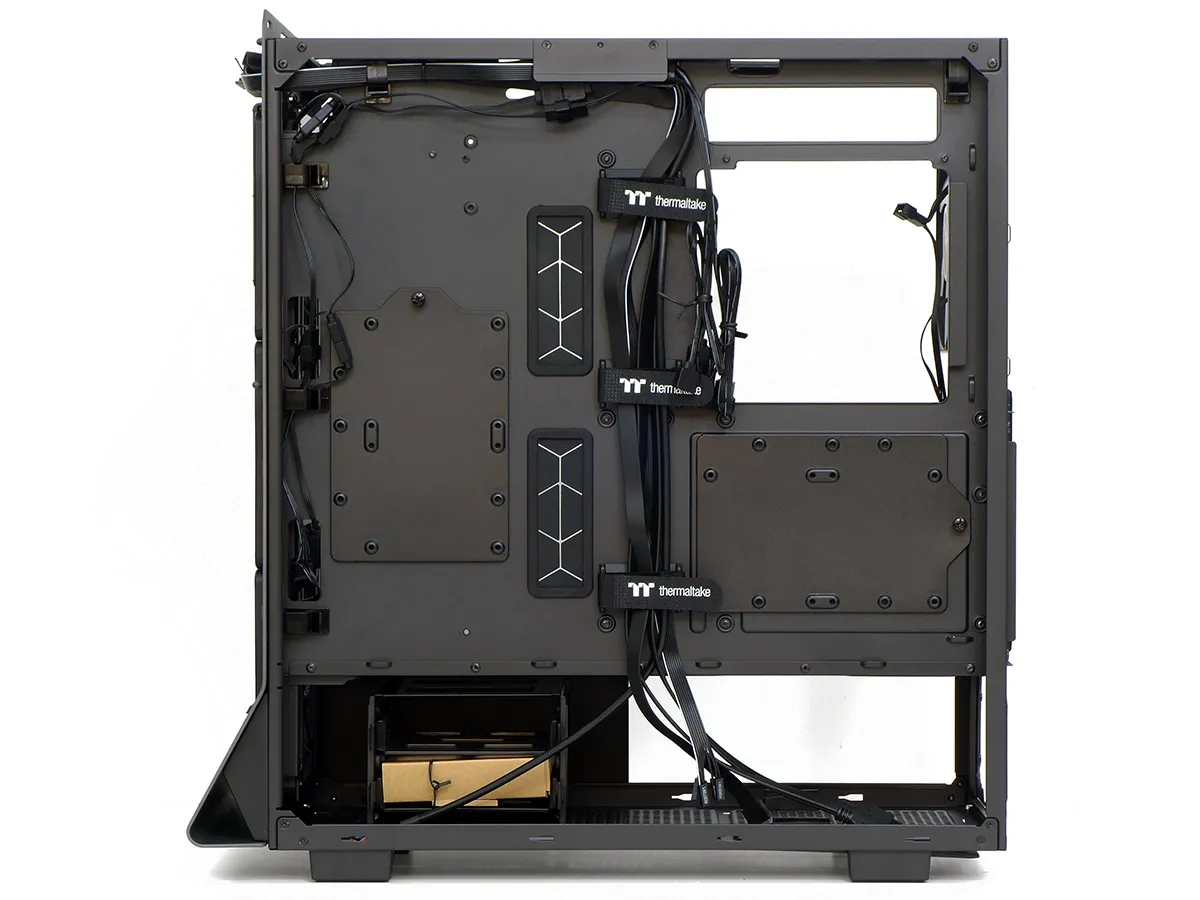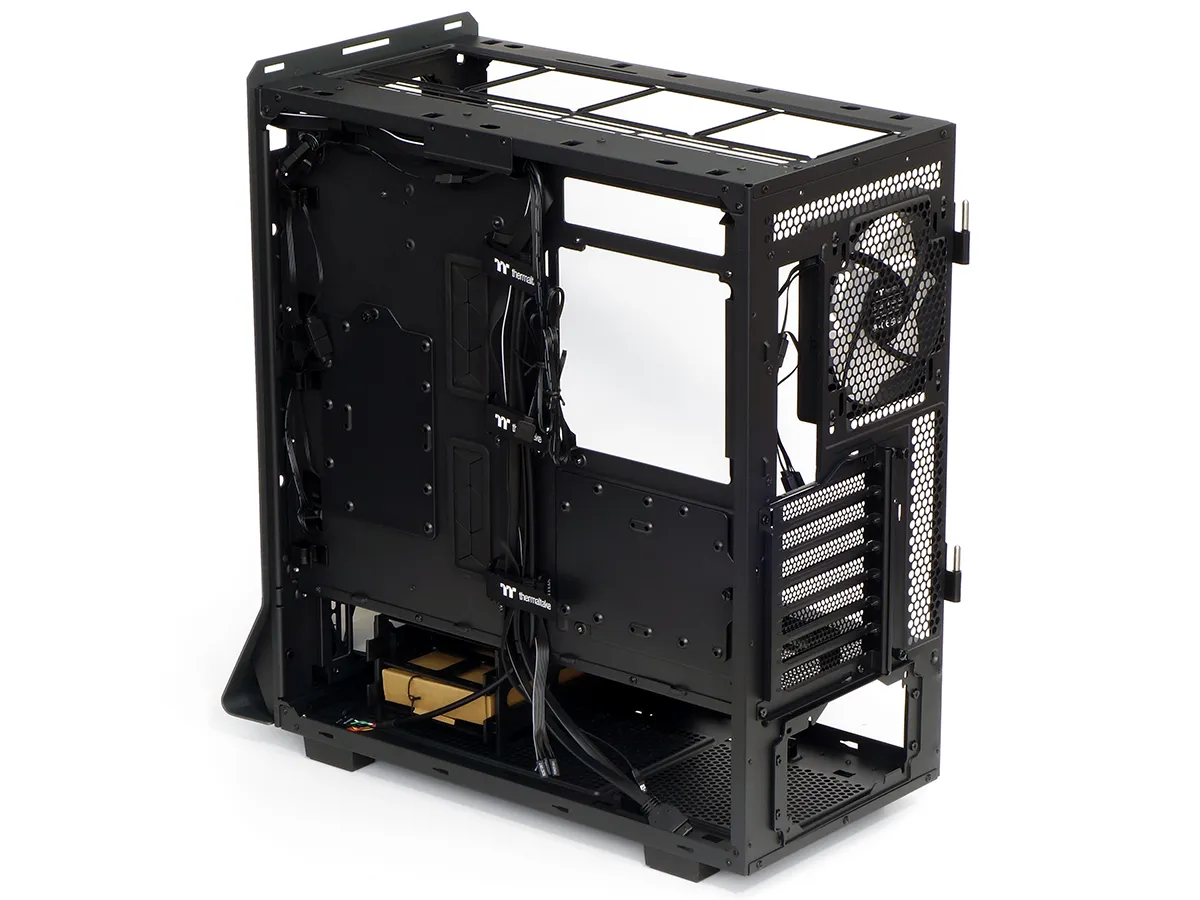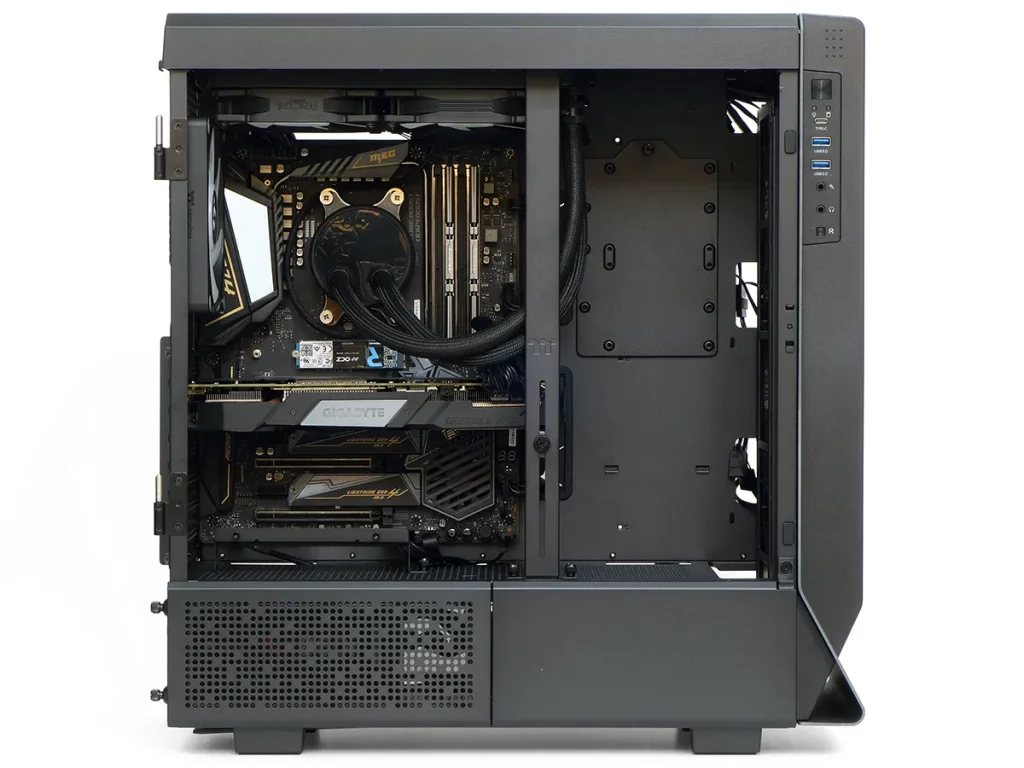Thermaltake Ceres 500 TG ARGB ATX Case Review
3/21 Update: Test fitting a Corsair H170i proved that the front opening was too small to tilt the ‘420mm’ radiator into place while mounted to the rack. Lowering the radiator into place with the rack removed worked, but the front panel brace obscured the lower fan mounting holes after dropping the rack back in. As a workaround, we attached the lowest fan to the bottom of the rack with two regular fan screws, dropped the rack into place ahead of the radiator, then attached the radiator to the fans using only ten (rather than 12) long screws. The cause for this appears to be that, at 457mm, the H170i radiator is 1mm longer than the one used in Thermaltake’s competing cooler.
Its name might indicate otherwise, but Thermaltake’s Ceres 500 TG ARGB is first and foremost all about the fans. Four 140mm fans happen to grace this beast, and all while these are ARGB, their first and foremost a way of moving air. Had the design been focused only on named qualities we imagine something with even more glass and a few light strips may have resulted. This is better.
| Thermaltake Ceres 500 TG ARGB | |||
| Type | Mid-Tower | Included Fans | (3) 140mm Front, (1) 140mm Rear |
| Motherboard Support | EATX, ATX, Micro ATX, Mini ITX | Front Fan Mounts | (3) 140mm / 120mm |
| Dimensions (HxWxD) | 20.1 x 10.0 x 20.0″ (51.0 x 25.4 x 50.8 cm) | Rear Fan Mounts | (1) 140mm / 120mm |
| Weight | 23.2 lbs (10.52 kg) | Top Fan Mounts | (3) 140mm / 120mm |
| Max M.board Depth | 16.8″ (42.5 cm) (w/o ft. rad.) | Bottom Fan Mounts | X |
| Card Length | 425mm (w/o front radiator) | Side Fan Mounts | X |
| Power Supply Format | PS/2: Max Depth 260mm (rated 220mm) | Top Rad. Clearance | 60mm vertical, 40mm horizontal (max) |
| Air Cooler Clearance | 185mm | Front Rad. Clearance | 35mm |
| External Bays | X | Front Filter | Nylon Mesh (rigid frame) |
| Internal Bays | Up to (5) 3.5″ or (8) 2.5″ (all shared) | Top Filter | Nylon Mesh (rigid frame) |
| Card Slots | 7 | Bottom Filter | Slide-out (from rear) nylon mesh |
| Ports/Jacks | (1) Gen2 Type-C, (2) Gen1 Type A, Headphone, Microphone | Damping | None |
| Other | X | Price | $170 |
Get it at Amazon

(click for availability)
Not only does it have four giant fans, but it can hold three more of this size on its top panel. It can also fit a 420mm-format radiator up front while leaving space for the builder’s choice of three 140mm fans or a 360mm-format radiator up top, complete with the appropriate triplet of 120mm fans.

One other feature of note is the width: Thermaltake’s rating of 9.6” doesn’t include that giant knob sticking out of the glass side panel, which adds another 0.4”. Users can of course fit the case into a 9 5/8″ space if they’re only shoving it into that space as far as that side knob. Our measured depth likewise includes all the rear panel thumb screws and brackets, of which the glass panel’s hinge is one of the lesser protrusions.

Front panel ports are located on a discrete trim plate inside the left edge of the removable panel, the later featuring gripping points on both sides to ease unsnapping it from the top so that it can be pivoted forward and lifted from tabs that retain it at the bottom. The port section includes a USB3 Type-C on a Gen2x2 interface cable, two USB3 Type A on a Gen1 cable, separate headphone and microphone ports, plus power and reset buttons.

The bottom panel’s dust filter also slides out from the front, but it’s so difficult to grasp that we had to tip the case backward to get ahold of it securely.

The Ceres 500 TG ARGB’s expansion slot section is removable and can be rotated 90° to support vertical graphics card mounting, though the case includes only one support bracket and no PCIe riser cable to finish that reconfiguration. Notice also that power supply mount is removable, that the rear edge of the opposite side panel is one continuous piece (meaning that the seam that separates the right side-panel into two pieces is a fake), and that the lower portion of the glass-paneled side appears to be two pieces.

Indeed, the left side’s lower panel is split between a vented section at the rear and a non-vented section at the front. The vented section even has its own rigid-framed washable dust filter with embedded magnets that hold it against the frame. That same filter type and attachment mechanism is used for both the front and top panels, which might explain why we see steel inserts on those panels.

The opening behind that tiny panel is too small to accommodate power supply installation, which explains the Ceres 500 TG ARGB’s inclusion of a removable power supply mount (the power supply slides in from the rear). We can also see the lower hinge pin for the glass side panel, which indicates how the panel is lifted off its hinges for removal. Inside the case we see the included bracket that supports PCIe riser cables when converting the case to a vertical graphics card configuration.

We like to see a minimum of 38mm front panel radiator clearance, yet the Ceres 500’s gap is only 35mm. Anyone concerned about how to best squeeze a radiator that thick into that space needs to know that the radiator/fan mount can be removed from the front of the case.


Other interior features include two large cable passages with rubber fillers in front of the ATX motherboard standoffs, an even larger cable passage above the top of motherboard stand offs, several smaller cable passages surrounding the motherboard tray, a giant hole that enables access to behind-motherboard CPU cooler support brackets, and a removable tray that supports either two 2.5” or one 3.5” drives. Removing the drive tray reveals two of the three additional standoff holes required to install 13”-deep motherboards.

The other side of the motherboard tray holds two more of the same 2x 2.5” / 1x 3.5” drive trays, and a drive cage in the power supply tunnel below it even holds two more trays. One of those lower trays is loaded with a cardboard box that’s filled with assembly hardware.


Unlike the drive trays that are fit against the motherboard tray, the trays inside the drive cage can only holds a single drive, even if it’s only in a 2.5” form factor drive. Adding those two single-drive 3.5″/2.5″ trays to the mix leaves the Ceres 500 TG ARGB able to support a maximum of eight 2.5” drives or five 3.5” drives or…you figure out the combo you need.

Building With The Ceres 500 TG ARGB
In addition to the box of hardware that was included in one of its drive bays, the Ceres 500 TG ARGB comes with a support kit for horizontal graphics cards strapped to the top of its power supply tunnel. The card support includes an upright strut that holds a horizontal bracket via an included thumb screw and a few more screws to secure it to the structural top panel and the top of the power supply tunnel. Meanwhile, the boxed hardware includes several cable ties, a PC speaker, and more screws than you could ever need to assemble your system: There are for example 35 #6-32 panhead screws for attaching the motherboard and any 3.5” drives, but even with an EATX board (12 screws) and 5 3.5” drives (20 screws) that’s three more than the entire system could use.

Cables include an ARGB pass-through and a PWM pass-through on each fan, HD Audio for the front-panel jacks, a standard front-panel button and LED set, USB3 Gen2x2 for the Type-C port, and USB3 Gen1 for the Type A ports. The front fan pass through connectors are linked together from the factory, leaving one ARGB and one PWM input for the front fans and one more for the rear fan.

| System Configuration | |
| CPU | AMD Ryzen 7 3700X: 8 cores/ 16 threads, 32MB L3 Cache O/C to 4.20 GHz (42x 100 MHz) at 1.3625 V Core |
| CPU Cooler | Fractal Design Celsius S24 2x 120mm Closed-Loop Liquid Cooler |
| Motherboard | MSI X570 Ace: AMD X570, Socket AM4 |
| RAM | T-Force Vulcan Z TLZGD416G3200HC16CDC0 DDR4-3200 |
| Graphics | Gigabyte GeForce RTX 2070 Gaming OC 8G: GeForce RTX 2070 1815 MHz GPU, GDDR6-14000, Maximum Fan When Listed |
| Hard Drives | Toshiba OCZ RD400 256GB NVMe SSD |
| Sound | Integrated HD Audio |
| Network | Integrated Gigabit Networking |
| Power | Corsair AX860i: ATX12V v2.3, EPS12V, 80 PLUS Platinum |
Other than screwing the card support brace to the top and center panels, our Ceres 500 TG ARGB build proceeded nearly like any other apart from one major flaw: None of those #6-32 panhead screws were round. We’re still trying to figure out how the supplier rolled threads onto screws that varied in shape from D-shaped to half square. After stripping out one of the standoff holes when a screw didn’t want to go in and then reinforcing that standoff by adding a #6-32 nut behind the motherboard tray, we finally achieved what we would otherwise consider normal build quality.

So striking was the appearance upon starting the system that we soon forgot about its out-of-round screws.

Test Results
| Test Configuration | |
| Load Software | AIDA 64 Engineer Version 6.00.5100, Stress CPU, FPU, Cache, GPU |
| H/W Monitoring | HWiNFO64 v6.28-4200 |
| SPL Monitoring | Galaxy CM-140 SPL Meter: Tested at 1/4 m, corrected to 1 m (-12 dB) |
With three front fans pushing enough air into the case to boost airflow through our all-in-one cooler, we shouldn’t be surprised to see the Ceres 500 winning the CPU temperature test. We’d think that it might actually win all four tests…if only the airflow goes past all the right places.

Our voltage regulator generally runs coolest when our AIO’s fans are close to it, but the extra distance inside the Ceres 500 might prove useful to someone who wants to run a thicker radiator. Too see so spacious a case come in at 1° behind the class leaders doesn’t bother us.

The Ceres 500 cools our motherboard’s chipset by around 2° less than the leading models.

GPU temperatures are also mid-pack. We’re not seeing a big enough difference to dissuade us from using the Ceres 500 TG ARGB where it’s needed though: It’s the only case in the group that can hold a 420mm-format radiator.

Noise is the biggest problem with having all those huge fans running at 1530 RPM behind a vented piece of sheet metal, but notice that the Ceres 500 TG ARGB’s 140mm fans barely make more noise than the 120mm fans of the MasterBox TD500 Mesh.

Having edged out its competitors in CPU temperature and lost by slim margins in every other performance metric, the Ceres 500 TG ARGB’s purpose is fully exposed: It can hold a 420mm-format radiator on its front panel. As somewhat of a bonus, it also includes an adjustable bracket that helps to support long, horizontally mounted graphics cards.
| Thermaltake Ceres 500 TG ARGB | |
| Pros: | Cons: |
|
|
| The Verdict: | |
| The Ceres 500 TG ARGB’s best feature is its ability to simultaneously support a 420mm-format front and a 360mm-format top radiator, but its current retail price exceeds our expectations by around 20%. | |
Get it at Amazon

(click for availability)
While it has other cost-adding features such as a slot panel that can be rotated to hold a card vertically and a mounting bracket for the PCIe cable needed to connect that card to a motherboard, the fact that it doesn’t include such a cable puts a bit of a crimp on the Ceres 500 TG ARGB’s value. At $170, we can only recommend it to specific buyers who require its large radiator support.
